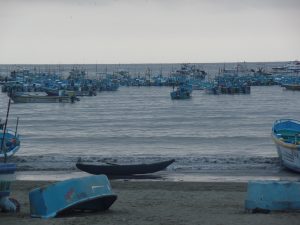The consortium is inviting faculty to become affiliated members.
“What we really want to do is incorporate a lot of the work that our faculty and staff are doing all over the world, and channel them through the consortium,” said O. Hugo Benavides, Ph.D., consortium director and chair of the sociology and anthropology department.
Collaborating to Avoid ‘Double Efforts’
Benavides formed the consortium last fall along with two co-directors: Aseel Sawalha, Ph.D., associate professor of anthropology, and Matthew Chin, Ph.D., assistant professor in the Graduate School of Social Service. GSC’s goal is to promote and integrate existing global research initiatives across the University’s different schools, departments, and programs—especially projects that are very similar.
“That’s one of the things we’re really interested in, so that people don’t do double efforts and reinvent the wheel,” said Benavides. “[With the consortium] they can reach out very easily to other colleagues that are doing similar work.”
To better understand the needs of his colleagues, Benavides and his colleagues hosted a forum this past November at the Lincoln Center campus. About 20 faculty members from at least four different schools sat at a table and shared their research objectives. A similar forum will be held next spring. Over the next couple of months, GSC will also create a consortium listserv and website.
“Our hope is to get people talking to each other so that they could do more collaborative research projects and apply for external grants,” Benavides said.
Research Abroad
The group is also planning for some travel. It will be co-sponsoring the third Fordham University Faculty Research Abroad Program (FRAP), designed to facilitate research collaboration between Fordham and foreign scholars, next summer in Rio de Janeiro, Brazil.
“Members who are affiliated to us have access to form different collaborations with other universities and colleagues at other universities,” Benavides said.
At the heart of the consortium is research that has an impact on local communities, said Benavides.
“We want to get involved with activists and artists and local communities and the kind of issues that are important and relevant to us today,” Benavides explained. “And particularly to use the strengths that our faculty have.”
Anyone interested in becoming a GSC affiliated faculty member should contact Benavides, Sawalha, or Chin at [email protected], [email protected], or [email protected].
]]>But when it comes to acceptance of sexual preference, it’s much, much further away. In Engabao, being gay is ok. In Guayaquil and in much of the rest of the country, it is not.
A Situation Reversed
For O. Hugo Benavides, Ph.D., a professor of anthropology, this is a source of great interest. In most countries, members of the LGTBQ community are more accepted in cities than they are in rural areas. In Ecuador—one of the most homophobic countries in the world, says Benavides—the situation is reversed. But why?
One clue may lie deep in the past, long before Spanish colonizers arrived.
According to historical writings, when the Spanish arrived in the 1500s, they encountered Enchaquirados—men and boys who wore ritualistic, high-status beads and engaged in same-sex relations with the male leaders of the community. The Spaniards looked down on them, but the Enchaquirados responded that they were chosen for the role, which they believed expressed a higher social status.
Fast forward to present-day Engabao. Since the 1990s, gay men there have been referring to themselves as Enchaquirados, said Benavides.
 “The gay community did a lot of what we would call political work in claiming this historical identity,” said Benavides. “They said, ‘We shouldn’t be discriminated against because we were actually here before the Spaniards arrived. There’s a heritage that’s historical, but it’s a sexual heritage as well.’”
“The gay community did a lot of what we would call political work in claiming this historical identity,” said Benavides. “They said, ‘We shouldn’t be discriminated against because we were actually here before the Spaniards arrived. There’s a heritage that’s historical, but it’s a sexual heritage as well.’”
One document that modern-day Enchaquirados have relied on to conduct workshops on the subject is “The Representation of Guayaquil’s Sexual Past: Historicizing the Enchaquirado.” Benavides, who grew up just 90 minutes away from Engabao, wrote it and, in 2002, got it published in the Journal of Latin American Anthropology .
An Ethnographic Exploration
This past summer, Benavides returned for a three-week-long ethnographic exploration of the village. His visit was part of larger project on pre-Hispanic sexuality being spearheaded by the anthropology department at the Jesuit University Pontificia Universidad Católica del Ecuador (PUCE) in Quito.
His colleague and research partner, Maria Fernanda Ugalde, Ph.D., professor and chair of anthropology at PUCE, has written extensively on two-thousand-year-old figurines from the region. She found male/female and female/female combinations, and figurines sporting large hips and breasts that are dressed in male attire.
 “You have all these combinations that have been put aside, or interpreted in a particular heterosexist way,” he said. “We’re trying to look at those not as exceptional, but rather as normative.”
“You have all these combinations that have been put aside, or interpreted in a particular heterosexist way,” he said. “We’re trying to look at those not as exceptional, but rather as normative.”
And Engabao is not unique. “All of these small fishing villages in the central and southern Ecuadorian coast have very similar elements, structures, or situations,” he said.
Benavides said he’s working to fund a larger ethnographic project to take place in the summer or the fall. Oddly enough, he found the biggest challenge in last summer’s research was simply trying to convince Engabao residents that their Enchaquirado identity was a unique phenomenon.
“They really see themselves and their identity as quite normal,” he said. “We’d ask them, ‘What does it mean to be from Engabao?’ and they’d answer like, ‘We live here, and we fish.'”
Benavides feels that the story of how Engabao’s tolerance came to be is an important piece of anthropological history for Ecuadorian culture.
“Professor Ugalde and I see the work we’re doing as important in trying to make the country, as a whole, more sensitive to both its historical and contemporary gender and sexual diversity,” he said.
]]>